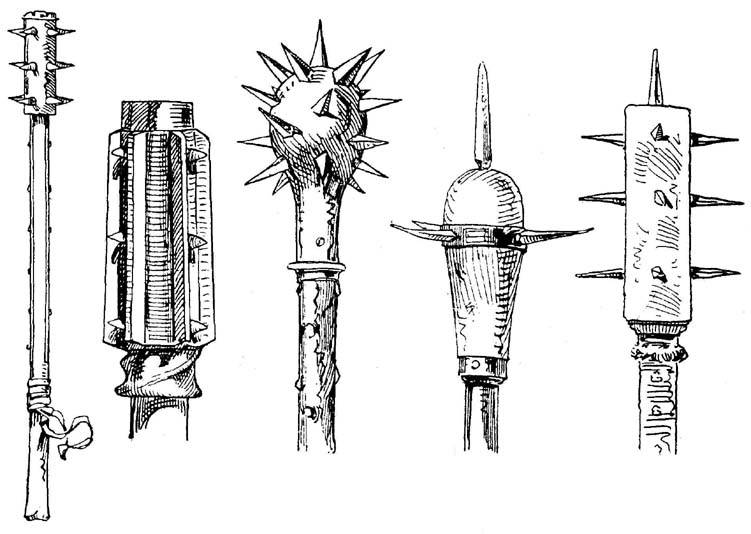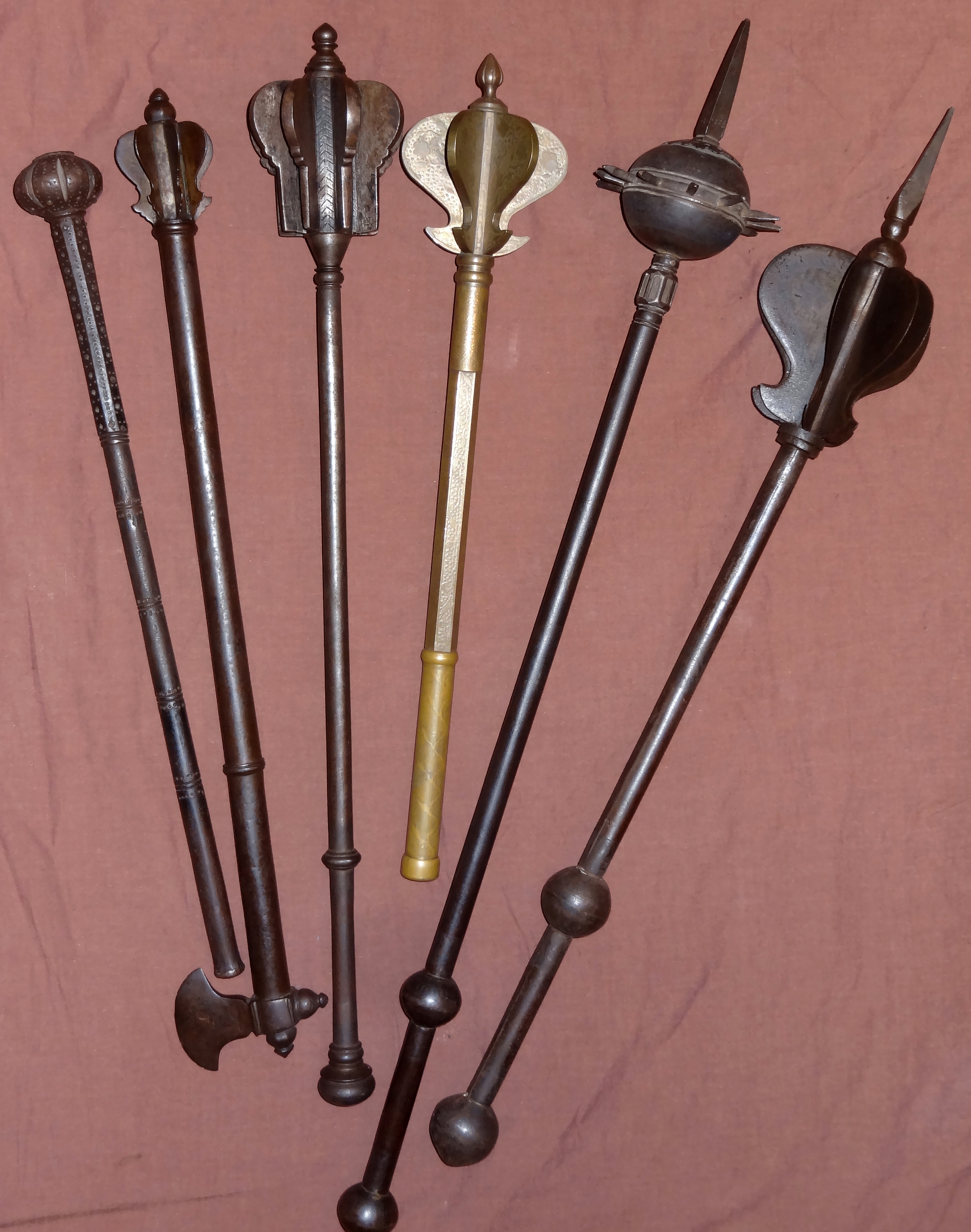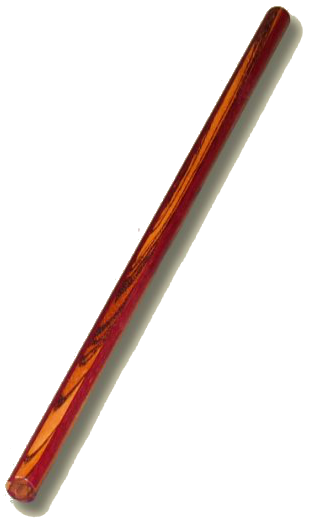|
Kanabō
The , or 'metal club') is a spiked or studded two-handed war club used in feudal Japan by samurai. Other related weapons of this type are the ''nyoibō'', ''konsaibō'', , and ''ararebō''.Mol, Serge (2003). ''Classical weaponry of Japan: special weapons and tactics of the martial arts''. Kodansha International. p. 91. Related solid iron weapons with no spikes or studs are the ''kanemuchi'' (or ''kanamuchi'') and the ''aribo'' (also known as a ''gojo'' or ''kirikobo''). Description ''Kanabō'' and other related club-like weapons were constructed out of heavy wood Wood is a structural tissue/material found as xylem in the stems and roots of trees and other woody plants. It is an organic materiala natural composite of cellulosic fibers that are strong in tension and embedded in a matrix of lignin t ... or made entirely from iron, with iron spikes or studs on one end. For wooden ''kanabō'', one or both ends could be covered with iron caps. ''Kanabō''-type weapons c ... [...More Info...] [...Related Items...] OR: [Wikipedia] [Google] [Baidu] |
Club (weapon)
A club (also known as a cudgel, baton, bludgeon, truncheon, cosh, nightstick, or impact weapon) is a short staff or stick, usually made of wood, wielded as a weapon or tool since prehistory. There are several examples of blunt trauma, blunt-force trauma caused by clubs in the past, including at the site of Nataruk in Turkana County, Turkana, Kenya, described as the scene of a prehistoric conflict between bands of hunter-gatherers 10,000 years ago. Most clubs are small enough to be swung with one hand, although larger clubs may require the use of two to be effective. Various specialized clubs are used in martial arts and other fields, including the Baton (law enforcement), law-enforcement baton. The military Mace (bludgeon), mace is a more sophisticated descendant of the club, typically made of metal and featuring a spiked, knobbed, or flanged head attached to a shaft. Examples of cultural depictions of clubs may be found in mythology, where they are associated with strong figure ... [...More Info...] [...Related Items...] OR: [Wikipedia] [Google] [Baidu] |
War Hammer
A war hammer (French: ''martel-de-fer'', "iron hammer") is a weapon that was used by both infantry, foot soldiers and cavalry. It is a very old weapon and gave its name, owing to its constant use, to Judas Maccabeus, Judah Maccabee, a 2nd-century BC Jewish rebel, and to Charles Martel, one of the rulers of France. In the 15th and 16th centuries, the war hammer became an elaborately decorated and handsome weapon. The war hammer was a popular weapon in the late Middle Ages, medieval period. It became somewhat of a necessity in combat when armor became so strong that swords and axes were no longer able to pierce and ricocheted upon impact. The war hammer could inflict significant damage on the enemy through their heavy impact without the need to pierce the armor. Design A war hammer consists of a handle and a head. The length of the handle may vary, the longest being roughly equivalent to that of a halberd (five to six feet or 1.5 to 1.8 meters), and the shortest about the same as t ... [...More Info...] [...Related Items...] OR: [Wikipedia] [Google] [Baidu] |
Morning Star (weapon)
A morning star () is any of several medieval club-like weapons consisting of a shaft with an attached ball adorned with one or more spikes. Such weapons provided their wielders with a combination of blunt-force and puncture attack to kill or wound an enemy. History The morning star first came into widespread use around the beginning of the fourteenth century, particularly in Germany where it was known as ''Morgenstern''. The term is often confused with the military flail (''fléau d'armes'' in French and ''Kriegsflegel'' in German), which typically consists of a wooden shaft joined by a length of chain to one or more iron-shod wooden bars. (Heavy sword pommels have also been used as weights.) However, there are few depictions of such a ball-and-chain flail from the period, so the weapon of this type appears to have been uncommon. Design The morning star is a medieval weapon consisting of a spiked head mounted on a shaft, resembling a mace, usually with a long spike exten ... [...More Info...] [...Related Items...] OR: [Wikipedia] [Google] [Baidu] |
Mace (bludgeon)
A mace is a blunt weapon, a type of Club (weapon), club or virge that uses a heavy head on the end of a handle to deliver powerful Strike (attack), strikes. A mace typically consists of a strong, heavy, wooden or metal shaft, often reinforced with metal, featuring a head made of stone, bone, copper, bronze, iron, or steel. The head of a mace can be shaped with flanges or knobs to increase the pressure of an impact by focusing the force on a small point. They would bind on metal instead of sliding around it, allowing them to deliver more force to an armored opponent than a traditional mace. This effect increased the potential for the mace to injure an armored opponent through weak spots in the armor, and even damage plate armor by denting it, potentially binding overlapping plates and impeding the wearer's range of motion. Medieval historian and re-enactor Todd Todeschini (AKA Todd Cutler) demonstrated this effect with period accurate equipment in a series of tests on video. Mac ... [...More Info...] [...Related Items...] OR: [Wikipedia] [Google] [Baidu] |
:Category:Japanese Words And Phrases ...
{{Commons Words and phrases by language Words Words Words A word is a basic element of language that carries meaning, can be used on its own, and is uninterruptible. Despite the fact that language speakers often have an intuitive grasp of what a word is, there is no consensus among linguists on its ... [...More Info...] [...Related Items...] OR: [Wikipedia] [Google] [Baidu] |
Statue
A statue is a free-standing sculpture in which the realistic, full-length figures of persons or animals are carved or Casting (metalworking), cast in a durable material such as wood, metal or stone. Typical statues are life-sized or close to life-size. A sculpture that represents persons or animals in full figure, but that is small enough to lift and carry is a ''statuette'' or figurine, whilst those that are more than twice life-size are regarded as '':colossal statues, colossal statues''. Statues have been produced in many cultures from prehistory to the present; the oldest-known statue dating to about 30,000 years ago. Statues represent many different people and animals, real and mythical. Many statues are placed in public places as public art. The world's tallest statue, ''Statue of Unity'', is tall and is located near the Narmada dam in Gujarat, India. Colors Ancient statues often show the bare surface of the material of which they are made. For example, many people as ... [...More Info...] [...Related Items...] OR: [Wikipedia] [Google] [Baidu] |
Macuahuitl
A macuahuitl () is a weapon, a wooden sword with several embedded obsidian blades. The name is derived from the Nahuatl language and means "hand-wood". Its sides are embedded with prismatic blades traditionally made from obsidian, which is capable of producing an edge sharper than high quality steel razor blades. The macuahuitl was a standard close combat weapon. Use of the macuahuitl as a weapon is attested from the first millennium CE, although specimens can be found in art dating to at least pre-classic times. By the time of the Spanish conquest the macuahuitl was widely distributed in Mesoamerica. The weapon was used by different civilisations including the Aztec (Mexicas), Olmec, Maya, Mixtec, Toltec, and Tarascans. One example of this weapon survived the Conquest of the Aztec Empire; it was part of the Royal Armoury of Madrid until it was destroyed by a fire in 1884. Images of the original designs survive in diverse catalogues. The oldest replica is the macuahuitl ... [...More Info...] [...Related Items...] OR: [Wikipedia] [Google] [Baidu] |
List Of Martial Arts Weapons
Weapons used in the world's martial arts can be classified either by type of weapon or by the martial arts school using them. By weapon type Handheld weapons * Bladed weapons **Swords: see Types of swords ** Knives **Daggers: see List of daggers ** Axe ** Sickle ** Kama **War hammer * Polearms ** Halberd ** Spear ** Guandao ** War scythe * Blunt weapons **Clubs/ Mace/ Baton ** Stick/ Staff/Sjambok ** Tonfa/ (side handled) baton ** Knuckleduster Projectile weapons * Bow and arrow * Crossbow * Bullet-shooting crossbow * Slingshot * Slings * Boomerang * Blowgun * Shuriken * Chakram * Firearm * Taser * Ballistic knife Flexible weapons * Chain weapons * Whips * Ropes * Tabak-Toyok * Slapjack * Nunchaku * Jōhyō Defensive weapons * List of defensive weapons ** Pepper spray ** Armours *** Shields By martial arts tradition * Eskrima * Kendo * Pencak Silat: Weapons of pencak silat * Kalarippayattu *Swordsmanship: ** Chinese swordsmanship ** Japanese swordsmanship * ... [...More Info...] [...Related Items...] OR: [Wikipedia] [Google] [Baidu] |
Tanbō
The is a short staff weapon used in Okinawa and feudal Japan. Today the is used by various martial arts schools. Description The is a short hardwood staff that is used in the same way as the approximately hanbō. Short staffs smaller than can be called . There is no official length for a as different ''ryū'' (martial arts schools) use of various lengths. can be individually sized using variations of the "hand to elbow" method. Usage The is used in several martial arts including: jujutsu, aikido, kobudo, hapkido, yoseikan budo, Cuong Nhu. are swung using the elbow and shoulder, or manipulated with the wrist. Many of the motions are similar to sword strokes. The can be deadly in skilled hands. The main use is to attack the outer edges of the human bones with speed and accuracy. Applying this concept, virtually every part of the target can be hit with this weapon. To use this weapon effectively, the opponent may be imagined as a 2-dimensional object standing i ... [...More Info...] [...Related Items...] OR: [Wikipedia] [Google] [Baidu] |
Hanbō
The ''hanbō'' (半棒, "half-staff") is a Stick fighting, staff used in martial arts. Traditionally, the ''hanbō'' was approximately three ''Shaku (unit), shaku'' or about long, half the length of the usual staff, the ''rokushakubō'' ("six ''shaku'' staff"). Diameter was . However, depending on the school the length and diameter varied. As with any weapon, bearers would often find one best suited to their build, opting often for one that comes up to about waist/hip height. Usage Hanbōjutsu, the art of wielding the ''hanbō'', is a focus in several martial arts including the ''Kukishin-ryū'' ''koryū'' classical school of martial arts, and ''Kukishinden-ryū'', one of the nine schools of ''Bujinkan Budo Taijutsu''. Part of the importance in using this length is that it is approximately that of a walking cane. Although techniques with a cane in this ''ryū-ha'' utilize pulling or hooking and possess one rounded end, they invariably function the same as a ''hanbō'' in all o ... [...More Info...] [...Related Items...] OR: [Wikipedia] [Google] [Baidu] |
Oni (folklore)
An ( ) is a kind of ''yōkai'', demon, orc, ogre, or troll in Japanese folklore. They are believed to live in caves or deep in the mountains or in hell. Oni are known for their superhuman strength and have been associated with powers like thunder and lightning, along with their evil nature manifesting in their propensity for murder and cannibalism. They are typically portrayed as hulking figures with one or more horns growing out of their heads, massive teeth, and occasionally a third eye in the center of the forehead."Oni." ''Handbook of Japanese Mythology'', by Michael Ashkenazi, ABC-CLIO, 2003, pp. 230–233. They are typically depicted with red, blue, black, or yellow colored skin, wearing loincloths of tiger pelt, and carrying iron kanabō clubs. They also have three to six digits on each hand and foot tipped with claw-like nails. Oni are able to change their looks to fool their victims into trusting them. Oni can be male or female, but have been predominantly male through ... [...More Info...] [...Related Items...] OR: [Wikipedia] [Google] [Baidu] |
Superhuman Strength
Superhuman strength is a superpower commonly invoked in fiction and other literary works, such as mythology. A fictionalized representation of the phenomenon of hysterical strength, it is the power to exert force and lift weights beyond what is physically possible for an ordinary human being. Alternate terms of superhuman strength have included ''enhanced strength'', ''super-strength'' and ''increased strength''. Superhuman strength is an amorphous ability, varying in potency depending on the writer or the context of the story in which it is depicted. Characters and deities with superhuman strength have been found in multiple ancient mythological accounts and religions. Superhuman strength is a common trope in fantasy and science fiction. This is generally by means of mechanisms such as cybernetic body parts, genetic modification, telekinetic fields in science fiction, or magical/supernatural sources within fantasy. A plethora of comic book superheroes and super-villains d ... [...More Info...] [...Related Items...] OR: [Wikipedia] [Google] [Baidu] |






